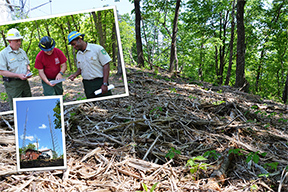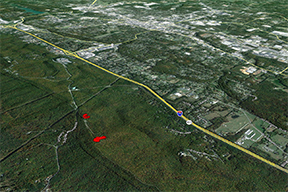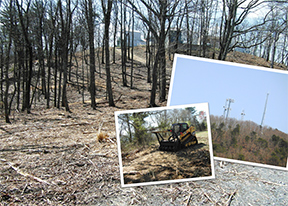Through an existing partnership agreement, the National Park Service assisted the U.S. Forest Service with a project that protected communications equipment on a mountaintop in northwestern Georgia.
“The importance of this site crossed all governmental and non-governmental boundaries. We accomplished this project in a safe manner, a timely manner, and a cost effective manner solely through partnership." Mike Ward, NPS Southeast Region Fuels Specialist
Protecting Critical Infrastructure

USFS/ Holly Krake
On a breezy March afternoon in 2015, the sounds of traffic rushing by on Interstate 75 travel up the base of a rocky mountain in north Georgia. On the narrow ridgetop, a group of wildland fire managers and the local fire chief look out into the surrounding national forest from a communications site covered in towers and antennae. This used to be a more heavily forested hilltop, but now the closest trees grow some 300 feet away from those critical towers.
“What a success” exclaims Dalton City Fire Chief, Bruce Satterfield. “Without this fuels treatment, a careless cigarette spark from the interstate could have raced up the mountain and destroyed the communications of nearly 600,000 people and countless emergency responders."
The group agrees and continues to discuss other potential wildfire mitigation work needed in the area. This conversation is one of many in a series of open conversations about wildfire risk in northwest Georgia. Starting in spring 2013, the US Forest Service (USFS), NPS, and local agencies agreed this site would be a critical value at risk in the event of a wildfire. They also agreed the site would be very difficult to protect due to the steep terrain, a single access point, lack of defensible space, and heavy fuel loading. Unable to mitigate the terrain or access concerns, USFS fire managers began to plan and discuss tools to increase defensible space and reduce fuel continuity on the national forest land. Top concerns included firefighter safety, influence on the wildland-urban interface (WUI), and cost effectiveness.
“By focusing on the arrangement and continuity of fuels, we were able to drop potential wildfire out of the canopy and midstory and onto the ground” said Chattahoochee-Oconee National Forest Fire Management Officer, Mike Davis. “This newly defensible space provides for much needed firefighter safety.”
Leveraging Partnerships

USFS
Through an existing partnership agreement, the Chattahoochee-Oconee National Forest was able to utilize a compact tracked loader equipped with a specialized mastication head, known as the ‘Getter’ that is owned and operated by NPS Southeast Region Fire Management. Working side by side with USFS hand crews, the ‘Getter’ shredded its way through more than 24 tons of woody material and overgrowth at the antennae site. Furthermore, this equipment allowed for increased firefighter safety through reducing exposure during site preparation and other mechanical fuels treatments that have historically been accomplished by hand. With more than 40 antennas perched across the narrow ridge, hand work would have diverted too many resources as well.
“The importance of this site crossed all governmental and non-governmental boundaries” said NPS Regional Fuels Specialist, Mike Ward. “We accomplished this project in a safe manner, a timely manner, and a cost effective manner solely through partnership.”
While there is still minor work remaining to complete the project, both USFS and NPS fire personnel are pleased with the cost-effectiveness of this wildfire risk mitigation effort. To date, the project has cost approximately $10,000.00 while protecting an estimated 50 million dollars in critical infrastructure. However the true economic cost would be exponential if communications were interrupted for major commercial users such as Norfolk Southern Railroad and Verizon Wireless.

USFS / Dequincy Gordon
Additionally, this effort has facilitated conversations with non-federal partners including state emergency management agencies regarding an ‘all-lands approach’ that is in alignment with the National Cohesive Strategy. In addition to housing the antennae of many commercial vendors, the site also contains the communications for state emergency management, local emergency medical services, fire departments, state highway patrol and the county sheriff. Dug Gap provides interoperability to multiple state and federal agencies in Georgia and Tennessee on a daily basis. By partnering to protect critical communication infrastructure, the NPS and USFS actively provided for firefighter safety and enhanced the full spectrum of responses to wildfire incidents across all agency and land ownership lines.
Last updated: December 14, 2017
